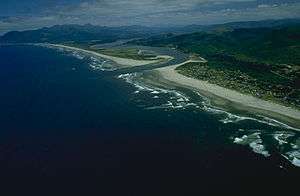Nehalem River
| Nehalem River | |
 Nehalem Bay at the mouth of the Nehalem River on the Pacific Ocean | |
| Name origin: Salish for "place where people live"[1] | |
| Country | United States |
|---|---|
| State | Oregon |
| County | Washington, Columbia, |
| Source | Northern Oregon Coast Range |
| - location | Giveout Mountain, Tillamook County, Oregon |
| - elevation | 2,424 ft (739 m) [2] |
| - coordinates | 45°43′53″N 123°25′26″W / 45.73139°N 123.42389°W [3] |
| Mouth | Nehalem Bay |
| - location | near Nehalem, Tillamook County, Oregon |
| - elevation | 0 ft (0 m) [3] |
| - coordinates | 45°39′29″N 123°56′04″W / 45.65806°N 123.93444°WCoordinates: 45°39′29″N 123°56′04″W / 45.65806°N 123.93444°W [3] |
| Length | 118.5 mi (190.7 km) [4] |
| Basin | 855 sq mi (2,214 km2) [4] |
| Discharge | for near Foss, 13.5 miles (21.7 km) from mouth |
| - average | 2,653 cu ft/s (75 m3/s) [5] |
| - max | 70,300 cu ft/s (1,991 m3/s) |
| - min | 34 cu ft/s (1 m3/s) |
|
Location of the mouth of the Nehalem River in Oregon | |
The Nehalem River is a river on the Pacific coast of northwest Oregon in the United States, approximately 119 miles (192 km) long. It drains part of the Northern Oregon Coast Range northwest of Portland, originating on the east side of the mountains and flowing in a loop around the north end of the range near the mouth of the Columbia River. Its watershed of 855 square miles (2,210 km2) includes an important timber-producing region of Oregon that was the site of the Tillamook Burn. In its upper reaches it flows through a long narrow valley of small mountain communities but is unpopulated along most of its lower reaches inland from the coast.
It rises in the northeast corner of Tillamook County, in the Tillamook State Forest. It initially flows northeast, across the northwest corner of Washington County and into western Columbia County, past Vernonia where it receives Rock Creek and Pittsburg. At Pittsburg, it looks to the northwest and west into Clatsop County, then flows southwest back into northern Tillamook County. It enters Nehalem Bay on the Pacific in an estuary at Nehalem, about 70 miles (110 km) west-northwest of Portland. Near its mouth on the Pacific, the river passes under U.S. Route 101.
It receives the Salmonberry River from the east in northern Tillamook County. It also receives the North Fork Nehalem River 25 miles (40 km) from the north about 2 miles (3.2 km) northwest of Nehalem, just before entering Nehalem Bay.
In 2007, a major storm caused the Salmonberry Bridge (located at 45°45′00″N 123°39′10″W / 45.7499°N 123.6528°W) to collapse. The bridge was rebuilt and opened to traffic on May 14, 2012.[6]
See also
References
- ↑ Loy, William G., ed.; Allan, Stuart; Buckley, Aileen R.; Meacham, James E. (2001). Atlas of Oregon, 2nd edition, revised. Eugene, Oregon: University of Oregon Press. p. 24. ISBN 0-87114-101-9.
- ↑ Source elevation derived from Google Earth search using GNIS source coordinates.
- 1 2 3 "Nehalem River". Geographic Names Information System. United States Geological Survey. November 28, 1980. Retrieved January 9, 2009.
- 1 2 Johnson, Jill. Maser, Joseph, ed. "Nehalem River Watershed Assessment 1.0 Introduction". Environmental Sciences and Resources Department, Portland State University. Retrieved January 17, 2009.
- ↑ "Water-data report 2007: 14301000 Nehalem River near Foss, OR" (pdf). United States Geological Survey. Retrieved January 17, 2009.
- ↑ "The Salmonberry Bridge Reopens". Tillamook Headlight-Herald. 15 May 2012. Retrieved 27 January 2014.
At long last The Salmonberry Bridge on Foss Road at m.p. 13 has been rebuilt and opened to traffic May 14. The bridge washed out in the 2007 storm.
External links
| Wikimedia Commons has media related to Nehalem River. |
- Nehalem River Watershed Assessment (PDF)
- Nehalem Valley Historical Society
- Oregon Coast Atlas: Nehalem River Estuary